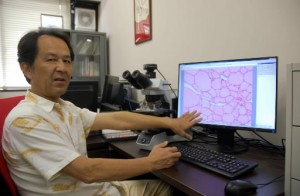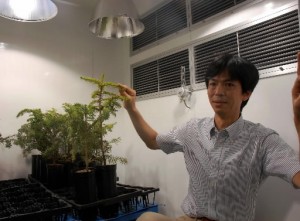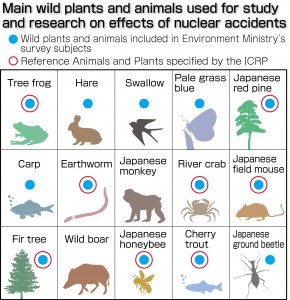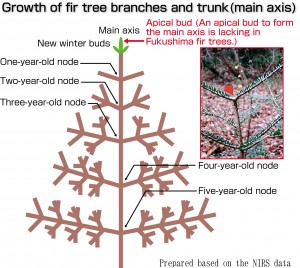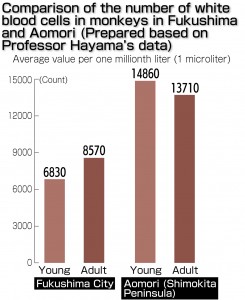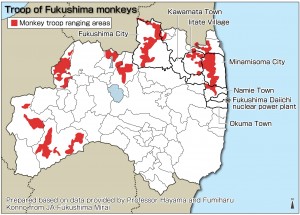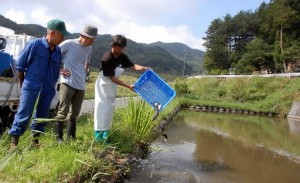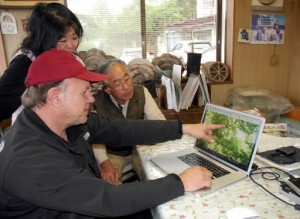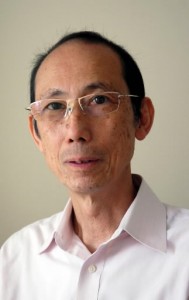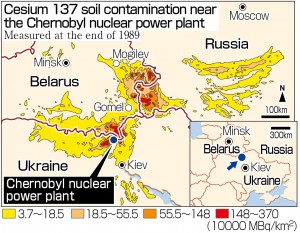Gray area: Effects of exposure to low-level radiation, Part 6 [2]
Sep. 24, 2016
Rethinking Fukushima: Abnormal changes in plants and animals
by Yumi Kanazaki and Yota Baba, Staff Writers
Nature, the silent victim of the Fukushima nuclear accident
Human beings are not the only ones to have suffered from the nuclear accident at the Fukushima No. 1 (Daiichi) nuclear power plant, operated by the Tokyo Electric Power Company (TEPCO). Wild animals and plants that inhabit the vast forests and rivers of Fukushima Prefecture have also been exposed to the radioactive substances that spewed from the nuclear plant. With no opportunity to evacuate, they have continued to live in their habitats for the past five and a half years, in areas contaminated with high levels of radiation to those with relatively low levels. In exploring this concern, researchers are studying the possible effects of radiation exposure on wild animals and plants. This article looks at the impact on nature, the silent victim, and examines the problems this poses to human beings.
Monkeys exposed to radiation 365 days a year
The Japanese monkeys that inhabit Fukushima Prefecture are the first wild primates in the world to have experienced a nuclear accident. Is our closest living creature suffering any ill effects from their radiation exposure?
Shinichi Hayama, a professor of wildlife zoology at Nippon Veterinary and Life Science University, located in Musashino City, Tokyo, used a red-colored sample of a thyroid gland on a microphotograph to show that, although the cells per unit area have increased in number and decreased in size, the thyroid gland has yet to turn cancerous.
Since 2008, before the nuclear accident occurred, Professor Hayama has been providing advice to the Fukushima city government on how to cull the population of monkeys to control the damage they do to the food crops of local residents. He has dissected monkey carcasses to check the condition of their health and their rate of pregnancy.
One month after the nuclear accident, Professor Hayama and the City of Fukushima began pursuing research on the effects of radiation on the monkeys. He made a comparison between monkeys which were caught for a year, starting in April 2012, with others living on the Shimokita Peninsula in Aomori Prefecture, which have not been exposed to radiation. From the research results, he discovered a worrying trend: both the numbers of white and red blood cells and the hemoglobin counts are lower in the Fukushima monkeys.
The number of white blood cells per microliter of blood in the monkeys from the Shimokita Peninsula was, on average, 14,860 in the young and 13,710 in the adults, while the number was 6,830 and 8,570 respectively for the monkeys from Fukushima. In the case of young monkeys, particularly those two and under, 81% have fewer white blood cells than the lowest number of white blood cells found in the Shimokita Peninsula monkeys.
Regarding the level of concentration of radioactive cesium in the monkeys’ muscle tissue, the level was so low that cesium was undetectable in the Shimokita Peninsula monkeys. To the contrary, the cesium level in the Fukushima monkeys ranged from 78 to 1,778 becquerels per kilogram. As the amount of radioactive cesium rose, the white blood cells became extremely small. This phenomenon was especially conspicuous in young Fukushima monkeys. Compared to the Shimokita Peninsula monkeys, there were more monkeys with a thyroid gland containing increased numbers of smaller cells per unit area.
Considering the fact that Fukushima City is located some 70 kilometers from the nuclear power plant, these findings are hard to believe. Unlike human beings, however, wild animals exist in an environment that is maximally exposed to radiation. They live 24 hours a day, 365 days a year in an outdoor setting in which no decontamination work is done while eating the food they catch in that environment. In the frigid winter, the monkeys strip and eat tree bark which readily absorbs radioactive cesium.
Professor Hayama’s research faces certain challenges. Because he handles monkeys that were selectively culled, he can use around 100 a year, at most, for his research. With this limitation, it is impossible to conduct a large-scale research project, as in animal experiments that include large numbers of mice or A-bomb survivor research in Hiroshima and Nagasaki which involves hundreds of thousands of survivors. It is also extremely difficult to accurately assess the exact levels of radiation exposure to wild organisms.
There is also criticism from researchers, both in and out of Japan, that the radiation exposure levels are too low to harm health and that the number of monkeys available for research is too small. Despite this criticism, Professor Hayama continues to ask whether it is reasonable to dismiss the changes which are clearly occurring in Fukushima simply because the levels of radiation exposure are considered to be too low to have a damaging effect.
This year, there will be female monkeys, born after the nuclear accident, that will get pregnant and give birth for the first time. These monkeys were born from mothers which took in radioactive substances each day through their food. Will there be any differences in the rate of pregnancy for these monkeys compared to the rate obtained before the nuclear accident? Professor Hayama will continue to study the effects of radiation exposure on newborn monkeys and on successive generations of monkeys. He says that the research will be discontinued when it is determined that the causal relationship with radiation exposure is unclear, and as a result, the damage done by radiation will be forgotten. Professor Hayama believes that if researchers persist in their efforts to continuously record data and pass this information down to future generations, their work will be of help in learning lessons from the nuclear accident.
Morphological changes in fir trees
This past August the Ministry of Environment released “Research on the effects of radiation on wild fauna and flora,” which states that “morphological changes have been observed.” But this observation was limited to fir trees. Further studies regarding the impact of radiation on wild fauna and flora are being carried out at the National Institute of Radiological Sciences (NIRS, located in Chiba) which provided the Ministry of Environment with the original data for this research.
Conifer trees are known to be especially sensitive to radiation, and morphological changes in this variety have been frequently observed since the accident in 1986 at the Chernobyl nuclear power plant, located in the former Soviet Union. In winter, some fir trees produce a bud, called an apical bud, which elongates vertically from the top of the tree. Apical buds form the main axis and produce other buds, called lateral buds, which elongate laterally and form branches. When fir trees are exposed to high levels of radiation, the lateral buds sometimes grow more vigorously than the apical bud.
In January 2015, NIRS selected three observation sites in the towns of Okuma and Namie, where radiation doses in the air were especially high within a 20 kilometer radius of the Fukushima No. 1 (Daiichi) nuclear power plant, and one other observation site for comparison. Researchers checked the conditions of 100 to 200 young fir trees at each observation site.
The results showed that at higher levels of radiation, there were more fir trees lacking an apical bud. This phenomenon was especially noticeable at the top of the main axis, which produced winter buds, and particularly in 2012, the year following the nuclear accident in Fukushima, and in 2013. Even four years after the accident, at observation sites in which hourly airborne radiation doses were as high as 33.9 microsieverts per hour, defective buds could be seen in 125 trees out of 128 trees.
Yoshito Watanabe, the head of this research, said, “These findings indicate that radiation could be a contributing factor to this phenomenon.” But he added that the morphological changes could also be caused by other factors and that morphological changes alone are not enough to assert that radiation is the sole cause. According to Mr. Watanabe, the morphological change in which the apical bud does not emerge and the tree becomes Y-shaped at its top is peculiar to Fukushima.
Currently, a reproduction experiment is being carried out to confirm that the bud at the top of the trunk will still become defective when it is exposed to radiation under certain conditions.
For this experiment, a system was installed that can control light and temperature to enable plants to grow in an environment similar to the environment outdoors. The researchers will use fir tree saplings grown under the same conditions and check for differences between before and after being exposed to radiation as well as changes in the samplings according to the radiation level. Mr. Watanabe said, “Through confirming these conditions scientifically, which is our duty as researchers, we would like to contribute to people’s safety and security.”
Among 80 fauna and flora, “changes only observed in fir trees” Since the nuclear accident in Fukushima, specialists at universities and institutes in Japan have been pursuing various research studies to explore the effects of radiation on wildlife. As a result of this research, it has been reported that abnormalities which are likely to be related to radiation were observed in cherry trout and pale grass blues, a type of small butterfly.
At the end of August, the Ministry of Environment summarized these findings and released the report titled “Research on the effects of radiation on wild fauna and flora.” The subjects of this research were 80 species of wild fauna and flora collected mainly within a 20 kilometer radius of the Fukushima nuclear power plant. Among the fauna and flora surveyed, the report says that external changes were observed only in fir trees that grow in areas in which there are high levels of radiation. With regard to the causal relationship to radiation, the report concludes that the relationship is still unclear.
Among the 80 species surveyed, the mammals collected were all small creatures: four species of mice, hares, and Japanese shrew moles (only six species in total). According to the Environment Ministry’s Nature Conservation Bureau, a Japanese monkey, a species peculiar to Japan, is not the subject of the follow-up survey because it is not included in the 12 Reference Animals and Plants specified by the International Commission on Radiological Protection (ICRP).
Studying such situations is a “researcher’s duty”
In the Maeda district in the village of Iitate in Fukushima Prefecture, a stretch of paddies and fields extends into the mountains. Yuzuru Suzuki, a professor emeritus at the University of Tokyo, arrived at a reservoir in a truck belonging to the university’s Fisheries Lab (in Hamamatsu City). After they were unloaded from the fish tank on the back of the truck, 40 young carp of about 20 centimeters in length began swimming together with other carp in the reservoir.
The release of the carp is part of the research into the effects of radiation exposure caused by the nuclear accident in Fukushima. For this research, mud down to a level of five centimeters deep was collected. In the previous study, undertaken two years ago, the level of radioactive cesium was 12,000 becquerels per one kilogram of dry mud. What is the level this time? Government standards specify that soil containing more than 8,000 becquerels of cesium be considered waste which requires special methods of disposal.
Mitsuo Hasegawa, 70, the owner of the reservoir, is lending his support to Professor Suzuki’s work and has given him permission to use the reservoir. Mr. Hasegawa said, “In the past, local children would catch carp with their hands and the fish was cooked at gatherings.” Mr. Hasegawa explained that he tosses food to the fish in the reservoir because this is better for them than surviving only on the sustenance found in mud.
Professor Suzuki has made many important achievements including clarifying the immune function of Japanese pufferfish and completing a detailed genome map. But when the nuclear accident in Fukushima occurred, he was so shocked that he changed his research focus to the effects of radiation, considering this his duty as a researcher. He chose to study carp because, unlike rivers, radioactive cesium readily accumulates in the water of ponds and marshlands and persists in these settings, and carp consume the mud along with their food. Thus, after his retirement in 2013, Professor Suzuki entrusted the gene analysis to other researchers at Kyushu University, and began his new research into the effects of radiation on carp with the help of the Fisheries Lab at his former workplace.
In 2013 and 2014, Professor Suzuki caught carp at six locations in the towns of Iitate and Minamisoma in Fukushima Prefecture and, for the purpose of comparison, at one location in Tochigi Prefecture. He discovered a decline in white blood cells in the carp that he caught in Fukushima Prefecture in 2013. He also found the rise of an inflammatory disorder and an abnormal increase in clumps of macrophages in the liver and spleen of Fukushima carp. In 2014, however, he found a slight increase in macrophages in carp from Tochigi Prefecture as well. As a result, the difference in the possible radiation effects between carp from Fukushima and Tochigi became difficult to discern.
This year, in order to increase the accuracy of his research, Professor Suzuki released a total of another 250 carp that had been cultivated for a year at a different location. For better comparison, he has also increased the number of ponds used in this research. In this way, he seeks to study any differences that may appear among carp that were bred under the same conditions.
“The heath effects of radiation, if any, can likely be more easily recognized in younger carp than the older, bigger carp that were born before the nuclear accident,” Professor Suzuki said. When he obtained a carp that was born after the nuclear accident in a pond in Okuma, a town close to the nuclear plant, then dissected it, he was shocked at the high concentration of radioactive cesium and the degree of abnormality in its liver cells. These findings are why he uses younger carp in his research.
In much of Iitate, where Mr. Hasegawa’s pond is located, a village-wide evacuation order will be lifted next March. In July of this year, residents were permitted to return to their homes for longer stays. Professor Suzuki said, “If the government promotes the policy that urges residents to return to their homes, they must be told about the radioactive contamination of the wildlife that inhabit the area.” Meanwhile, Professor Suzuki will continue with his research, catching the newly released carp next year.
Biological changes should not be underestimated
In the accident at the Chernobyl nuclear power plant in the former Soviet Union, which occurred in 1986, a massive amount of radioactive materials were dispersed into the environment by the explosion of the nuclear reactor and subsequent fire. After the accident, various fields of study, including biology and biology genetics, reported on the radiation effects on wildlife. Although the consequences of the Fukushima accident were not as widespread as the disaster at Chernobyl, radioactive substances were still strewn over a wide area in northeastern Japan. Timothy Mousseau, a professor of biology at the University of South Carolina, is one of the researchers pursuing research at both accident sites.
Professor Mousseau has been making observations in Ukraine and Belarus, starting 14 years after the Chernobyl accident, and he has reported that many cataract cases were observed in birds living in areas affected by that disaster. In Fukushima, he entered areas contaminated with high levels of radiation for the first time in July 2011, four months after the accident. Since then he has traveled back and forth between the United States and Japan some 20 times.
Professor Mousseau is carrying out his research in collaboration with Chubu University (Aichi Prefecture) and the University of Paris-Sud (Paris 11). He also relies on the cooperation of local residents in his studies. A shed owned by Hidekatsu Ouchi in the Yamakiya district of the town of Kawamata is the base for Professor Mousseau’s field activities. His research team installed automatic cameras at 45 locations in forests and along roadsides in Iitate and Namie to monitor the population and changes in behavior of the animals depending on the differences in air radiation doses. The research team also frequently captures and observes the insects and birds.
Professor Mousseau wonders whether genetic damages accumulate and are passed down over generations. In his work, he has come across a case in which a living creature has adapted itself to the new, radioactive environment. He argues that the issue of exposure to low-level radiation should also be examined from the point of view of ecosystems and biodiversity.
Currently, phenomena that are both different from and common to the effects found in Chernobyl are being observed.
In the year following the Fukushima accident, Professor Mousseau examined baby swallows within a 20 kilometer radius of the nuclear power plant in Fukushima, as well as those in the nearby vicinity. Their nests were found to be heavily contaminated with radiation, but no DNA damage was observed. He summarized his findings in a research paper and then examined the differences between these birds and those in Chernobyl, where highly poisonous strontium and americium was dispersed.
Upon examining the phenomenon where the feathers around the beak and on the head turn white, albinism was seen in 8.9 birds per 1,000 birds in Denmark, while 66.5 birds per 1,000 birds demonstrated the same trait in Chernobyl. This phenomenon, also frequently seen in birds in Fukushima, is considered a biomarker of radiation exposure.
With regard to the nuclear accident in Fukushima, various field survey reports have already been collected. However, those that were released by some international institutions hold many discrepancies.
In the 2013 “Report compiled by the United Nations Scientific Committee on the Effects of Atomic Radiation regarding the Fukushima nuclear accident,” the committee concluded that “the possibility of effects on biota was geographically constrained.” In the IAEA’s (International Atomic Energy Agency) report published in 2006 regarding the environmental consequences of the Chernobyl accident, it is stated that in heavily contaminated areas where the general public has been excluded, in particular, “the ecosystems are now flourishing, and the present environmental conditions have had a positive impact.”
Professor Mousseau is critical of these reports, saying that they have underestimated the impact of the nuclear accidents. He insists on persevering in this evidence-based research to determine scientifically whether or not the various phenomena observed in these locations are the consequence of radiation exposure.
Interview with Manabu Fukumoto, emeritus professor at Tohoku University: Importance of examining animals to investigate internal exposure
What is the significance, and the difficulty, of studying the effects of radiation by using living creatures, other than human beings? For a further look at the levels of radiation that domestic animals and wildlife have been exposed to as a result of the nuclear accident in Fukushima, the Chugoku Shimbun interviewed Manabu Fukumoto, a professor emeritus of radiopathology at Tohoku University who has led various joint research projects with several universities.
I had originally been studying the relationship between intrahepatic bile duct cancer and long-term exposure to thorotrast by genetically analyzing the pathologic tissue samples. Thorotrast is an angiographic agent that was frequently administered to wounded soldiers. One month after the nuclear accident, entry within the 20 kilometer radius of the Fukushima nuclear power plant was generally forbidden, and, furthermore, the government issued a decree to Fukushima Prefecture that all livestock left behind be killed. This prompted my research into the levels of radiation exposure affecting animals.
It has been reported that 3,400 cows were killed in line with the government decree. To ensure that the unfortunate sacrifice of these cows’ lives will not be in vain, I think we should make use of their demise by obtaining research data on animals internally exposed to radiation for future generations. Such data will be an important asset in scientifically clarifying the effects of radiation on human health. In addition to the blood and internal organs of livestock, I have kept and analyzed the bone marrow of Japanese monkeys that were culled within the 20 kilometer radius of the nuclear plant.
As a result, it was found that radioactive cesium tends to accumulate more in young cows than parent cows and that there had been no damage to the bull’s testis within one year after the accident. These findings were published in my report.
Most people tend to worry about the hourly air radiation dose. The hourly air radiation dose can be used as the standard for evaluating the external radiation exposure dose, but it does not reflect the levels of radioactive materials taken into the body.
Compared to follow-up investigations of A-bomb survivors who were exposed to massive levels of radiation instantaneously, research into the effects of low-dose radiation exposure, especially long-term internal exposure, has made little progress. What types of radioactive material tend to accumulate and in which organs do they accumulate? What kinds of health problems does this cause? After the unfortunate accident, there is a great deal we can learn from animals through dissection.
Recently, on a nationwide basis, government subsidies for university running costs and university staff numbers have been reduced. As a result, maintaining continuity in this research has become very difficult. I myself retired this past spring, but no new researcher has come to continue my work. The research environment has changed completely compared to five years ago, when the nuclear accident occurred. In the investigations involving A-bomb survivors, many things became clear after several decades of study. In studying the effects of low-level exposure to radiation, long-term research, in particular, is essential.
(Originally published on September 24, 2016)
by Yumi Kanazaki and Yota Baba, Staff Writers
Nature, the silent victim of the Fukushima nuclear accident
Human beings are not the only ones to have suffered from the nuclear accident at the Fukushima No. 1 (Daiichi) nuclear power plant, operated by the Tokyo Electric Power Company (TEPCO). Wild animals and plants that inhabit the vast forests and rivers of Fukushima Prefecture have also been exposed to the radioactive substances that spewed from the nuclear plant. With no opportunity to evacuate, they have continued to live in their habitats for the past five and a half years, in areas contaminated with high levels of radiation to those with relatively low levels. In exploring this concern, researchers are studying the possible effects of radiation exposure on wild animals and plants. This article looks at the impact on nature, the silent victim, and examines the problems this poses to human beings.
Monkeys exposed to radiation 365 days a year
The Japanese monkeys that inhabit Fukushima Prefecture are the first wild primates in the world to have experienced a nuclear accident. Is our closest living creature suffering any ill effects from their radiation exposure?
Shinichi Hayama, a professor of wildlife zoology at Nippon Veterinary and Life Science University, located in Musashino City, Tokyo, used a red-colored sample of a thyroid gland on a microphotograph to show that, although the cells per unit area have increased in number and decreased in size, the thyroid gland has yet to turn cancerous.
Since 2008, before the nuclear accident occurred, Professor Hayama has been providing advice to the Fukushima city government on how to cull the population of monkeys to control the damage they do to the food crops of local residents. He has dissected monkey carcasses to check the condition of their health and their rate of pregnancy.
One month after the nuclear accident, Professor Hayama and the City of Fukushima began pursuing research on the effects of radiation on the monkeys. He made a comparison between monkeys which were caught for a year, starting in April 2012, with others living on the Shimokita Peninsula in Aomori Prefecture, which have not been exposed to radiation. From the research results, he discovered a worrying trend: both the numbers of white and red blood cells and the hemoglobin counts are lower in the Fukushima monkeys.
The number of white blood cells per microliter of blood in the monkeys from the Shimokita Peninsula was, on average, 14,860 in the young and 13,710 in the adults, while the number was 6,830 and 8,570 respectively for the monkeys from Fukushima. In the case of young monkeys, particularly those two and under, 81% have fewer white blood cells than the lowest number of white blood cells found in the Shimokita Peninsula monkeys.
Regarding the level of concentration of radioactive cesium in the monkeys’ muscle tissue, the level was so low that cesium was undetectable in the Shimokita Peninsula monkeys. To the contrary, the cesium level in the Fukushima monkeys ranged from 78 to 1,778 becquerels per kilogram. As the amount of radioactive cesium rose, the white blood cells became extremely small. This phenomenon was especially conspicuous in young Fukushima monkeys. Compared to the Shimokita Peninsula monkeys, there were more monkeys with a thyroid gland containing increased numbers of smaller cells per unit area.
Considering the fact that Fukushima City is located some 70 kilometers from the nuclear power plant, these findings are hard to believe. Unlike human beings, however, wild animals exist in an environment that is maximally exposed to radiation. They live 24 hours a day, 365 days a year in an outdoor setting in which no decontamination work is done while eating the food they catch in that environment. In the frigid winter, the monkeys strip and eat tree bark which readily absorbs radioactive cesium.
Professor Hayama’s research faces certain challenges. Because he handles monkeys that were selectively culled, he can use around 100 a year, at most, for his research. With this limitation, it is impossible to conduct a large-scale research project, as in animal experiments that include large numbers of mice or A-bomb survivor research in Hiroshima and Nagasaki which involves hundreds of thousands of survivors. It is also extremely difficult to accurately assess the exact levels of radiation exposure to wild organisms.
There is also criticism from researchers, both in and out of Japan, that the radiation exposure levels are too low to harm health and that the number of monkeys available for research is too small. Despite this criticism, Professor Hayama continues to ask whether it is reasonable to dismiss the changes which are clearly occurring in Fukushima simply because the levels of radiation exposure are considered to be too low to have a damaging effect.
This year, there will be female monkeys, born after the nuclear accident, that will get pregnant and give birth for the first time. These monkeys were born from mothers which took in radioactive substances each day through their food. Will there be any differences in the rate of pregnancy for these monkeys compared to the rate obtained before the nuclear accident? Professor Hayama will continue to study the effects of radiation exposure on newborn monkeys and on successive generations of monkeys. He says that the research will be discontinued when it is determined that the causal relationship with radiation exposure is unclear, and as a result, the damage done by radiation will be forgotten. Professor Hayama believes that if researchers persist in their efforts to continuously record data and pass this information down to future generations, their work will be of help in learning lessons from the nuclear accident.
Morphological changes in fir trees
This past August the Ministry of Environment released “Research on the effects of radiation on wild fauna and flora,” which states that “morphological changes have been observed.” But this observation was limited to fir trees. Further studies regarding the impact of radiation on wild fauna and flora are being carried out at the National Institute of Radiological Sciences (NIRS, located in Chiba) which provided the Ministry of Environment with the original data for this research.
Conifer trees are known to be especially sensitive to radiation, and morphological changes in this variety have been frequently observed since the accident in 1986 at the Chernobyl nuclear power plant, located in the former Soviet Union. In winter, some fir trees produce a bud, called an apical bud, which elongates vertically from the top of the tree. Apical buds form the main axis and produce other buds, called lateral buds, which elongate laterally and form branches. When fir trees are exposed to high levels of radiation, the lateral buds sometimes grow more vigorously than the apical bud.
In January 2015, NIRS selected three observation sites in the towns of Okuma and Namie, where radiation doses in the air were especially high within a 20 kilometer radius of the Fukushima No. 1 (Daiichi) nuclear power plant, and one other observation site for comparison. Researchers checked the conditions of 100 to 200 young fir trees at each observation site.
The results showed that at higher levels of radiation, there were more fir trees lacking an apical bud. This phenomenon was especially noticeable at the top of the main axis, which produced winter buds, and particularly in 2012, the year following the nuclear accident in Fukushima, and in 2013. Even four years after the accident, at observation sites in which hourly airborne radiation doses were as high as 33.9 microsieverts per hour, defective buds could be seen in 125 trees out of 128 trees.
Yoshito Watanabe, the head of this research, said, “These findings indicate that radiation could be a contributing factor to this phenomenon.” But he added that the morphological changes could also be caused by other factors and that morphological changes alone are not enough to assert that radiation is the sole cause. According to Mr. Watanabe, the morphological change in which the apical bud does not emerge and the tree becomes Y-shaped at its top is peculiar to Fukushima.
Currently, a reproduction experiment is being carried out to confirm that the bud at the top of the trunk will still become defective when it is exposed to radiation under certain conditions.
For this experiment, a system was installed that can control light and temperature to enable plants to grow in an environment similar to the environment outdoors. The researchers will use fir tree saplings grown under the same conditions and check for differences between before and after being exposed to radiation as well as changes in the samplings according to the radiation level. Mr. Watanabe said, “Through confirming these conditions scientifically, which is our duty as researchers, we would like to contribute to people’s safety and security.”
Among 80 fauna and flora, “changes only observed in fir trees” Since the nuclear accident in Fukushima, specialists at universities and institutes in Japan have been pursuing various research studies to explore the effects of radiation on wildlife. As a result of this research, it has been reported that abnormalities which are likely to be related to radiation were observed in cherry trout and pale grass blues, a type of small butterfly.
At the end of August, the Ministry of Environment summarized these findings and released the report titled “Research on the effects of radiation on wild fauna and flora.” The subjects of this research were 80 species of wild fauna and flora collected mainly within a 20 kilometer radius of the Fukushima nuclear power plant. Among the fauna and flora surveyed, the report says that external changes were observed only in fir trees that grow in areas in which there are high levels of radiation. With regard to the causal relationship to radiation, the report concludes that the relationship is still unclear.
Among the 80 species surveyed, the mammals collected were all small creatures: four species of mice, hares, and Japanese shrew moles (only six species in total). According to the Environment Ministry’s Nature Conservation Bureau, a Japanese monkey, a species peculiar to Japan, is not the subject of the follow-up survey because it is not included in the 12 Reference Animals and Plants specified by the International Commission on Radiological Protection (ICRP).
Studying such situations is a “researcher’s duty”
In the Maeda district in the village of Iitate in Fukushima Prefecture, a stretch of paddies and fields extends into the mountains. Yuzuru Suzuki, a professor emeritus at the University of Tokyo, arrived at a reservoir in a truck belonging to the university’s Fisheries Lab (in Hamamatsu City). After they were unloaded from the fish tank on the back of the truck, 40 young carp of about 20 centimeters in length began swimming together with other carp in the reservoir.
The release of the carp is part of the research into the effects of radiation exposure caused by the nuclear accident in Fukushima. For this research, mud down to a level of five centimeters deep was collected. In the previous study, undertaken two years ago, the level of radioactive cesium was 12,000 becquerels per one kilogram of dry mud. What is the level this time? Government standards specify that soil containing more than 8,000 becquerels of cesium be considered waste which requires special methods of disposal.
Mitsuo Hasegawa, 70, the owner of the reservoir, is lending his support to Professor Suzuki’s work and has given him permission to use the reservoir. Mr. Hasegawa said, “In the past, local children would catch carp with their hands and the fish was cooked at gatherings.” Mr. Hasegawa explained that he tosses food to the fish in the reservoir because this is better for them than surviving only on the sustenance found in mud.
Professor Suzuki has made many important achievements including clarifying the immune function of Japanese pufferfish and completing a detailed genome map. But when the nuclear accident in Fukushima occurred, he was so shocked that he changed his research focus to the effects of radiation, considering this his duty as a researcher. He chose to study carp because, unlike rivers, radioactive cesium readily accumulates in the water of ponds and marshlands and persists in these settings, and carp consume the mud along with their food. Thus, after his retirement in 2013, Professor Suzuki entrusted the gene analysis to other researchers at Kyushu University, and began his new research into the effects of radiation on carp with the help of the Fisheries Lab at his former workplace.
In 2013 and 2014, Professor Suzuki caught carp at six locations in the towns of Iitate and Minamisoma in Fukushima Prefecture and, for the purpose of comparison, at one location in Tochigi Prefecture. He discovered a decline in white blood cells in the carp that he caught in Fukushima Prefecture in 2013. He also found the rise of an inflammatory disorder and an abnormal increase in clumps of macrophages in the liver and spleen of Fukushima carp. In 2014, however, he found a slight increase in macrophages in carp from Tochigi Prefecture as well. As a result, the difference in the possible radiation effects between carp from Fukushima and Tochigi became difficult to discern.
This year, in order to increase the accuracy of his research, Professor Suzuki released a total of another 250 carp that had been cultivated for a year at a different location. For better comparison, he has also increased the number of ponds used in this research. In this way, he seeks to study any differences that may appear among carp that were bred under the same conditions.
“The heath effects of radiation, if any, can likely be more easily recognized in younger carp than the older, bigger carp that were born before the nuclear accident,” Professor Suzuki said. When he obtained a carp that was born after the nuclear accident in a pond in Okuma, a town close to the nuclear plant, then dissected it, he was shocked at the high concentration of radioactive cesium and the degree of abnormality in its liver cells. These findings are why he uses younger carp in his research.
In much of Iitate, where Mr. Hasegawa’s pond is located, a village-wide evacuation order will be lifted next March. In July of this year, residents were permitted to return to their homes for longer stays. Professor Suzuki said, “If the government promotes the policy that urges residents to return to their homes, they must be told about the radioactive contamination of the wildlife that inhabit the area.” Meanwhile, Professor Suzuki will continue with his research, catching the newly released carp next year.
Biological changes should not be underestimated
In the accident at the Chernobyl nuclear power plant in the former Soviet Union, which occurred in 1986, a massive amount of radioactive materials were dispersed into the environment by the explosion of the nuclear reactor and subsequent fire. After the accident, various fields of study, including biology and biology genetics, reported on the radiation effects on wildlife. Although the consequences of the Fukushima accident were not as widespread as the disaster at Chernobyl, radioactive substances were still strewn over a wide area in northeastern Japan. Timothy Mousseau, a professor of biology at the University of South Carolina, is one of the researchers pursuing research at both accident sites.
Professor Mousseau has been making observations in Ukraine and Belarus, starting 14 years after the Chernobyl accident, and he has reported that many cataract cases were observed in birds living in areas affected by that disaster. In Fukushima, he entered areas contaminated with high levels of radiation for the first time in July 2011, four months after the accident. Since then he has traveled back and forth between the United States and Japan some 20 times.
Professor Mousseau is carrying out his research in collaboration with Chubu University (Aichi Prefecture) and the University of Paris-Sud (Paris 11). He also relies on the cooperation of local residents in his studies. A shed owned by Hidekatsu Ouchi in the Yamakiya district of the town of Kawamata is the base for Professor Mousseau’s field activities. His research team installed automatic cameras at 45 locations in forests and along roadsides in Iitate and Namie to monitor the population and changes in behavior of the animals depending on the differences in air radiation doses. The research team also frequently captures and observes the insects and birds.
Professor Mousseau wonders whether genetic damages accumulate and are passed down over generations. In his work, he has come across a case in which a living creature has adapted itself to the new, radioactive environment. He argues that the issue of exposure to low-level radiation should also be examined from the point of view of ecosystems and biodiversity.
Currently, phenomena that are both different from and common to the effects found in Chernobyl are being observed.
In the year following the Fukushima accident, Professor Mousseau examined baby swallows within a 20 kilometer radius of the nuclear power plant in Fukushima, as well as those in the nearby vicinity. Their nests were found to be heavily contaminated with radiation, but no DNA damage was observed. He summarized his findings in a research paper and then examined the differences between these birds and those in Chernobyl, where highly poisonous strontium and americium was dispersed.
Upon examining the phenomenon where the feathers around the beak and on the head turn white, albinism was seen in 8.9 birds per 1,000 birds in Denmark, while 66.5 birds per 1,000 birds demonstrated the same trait in Chernobyl. This phenomenon, also frequently seen in birds in Fukushima, is considered a biomarker of radiation exposure.
With regard to the nuclear accident in Fukushima, various field survey reports have already been collected. However, those that were released by some international institutions hold many discrepancies.
In the 2013 “Report compiled by the United Nations Scientific Committee on the Effects of Atomic Radiation regarding the Fukushima nuclear accident,” the committee concluded that “the possibility of effects on biota was geographically constrained.” In the IAEA’s (International Atomic Energy Agency) report published in 2006 regarding the environmental consequences of the Chernobyl accident, it is stated that in heavily contaminated areas where the general public has been excluded, in particular, “the ecosystems are now flourishing, and the present environmental conditions have had a positive impact.”
Professor Mousseau is critical of these reports, saying that they have underestimated the impact of the nuclear accidents. He insists on persevering in this evidence-based research to determine scientifically whether or not the various phenomena observed in these locations are the consequence of radiation exposure.
Interview with Manabu Fukumoto, emeritus professor at Tohoku University: Importance of examining animals to investigate internal exposure
What is the significance, and the difficulty, of studying the effects of radiation by using living creatures, other than human beings? For a further look at the levels of radiation that domestic animals and wildlife have been exposed to as a result of the nuclear accident in Fukushima, the Chugoku Shimbun interviewed Manabu Fukumoto, a professor emeritus of radiopathology at Tohoku University who has led various joint research projects with several universities.
I had originally been studying the relationship between intrahepatic bile duct cancer and long-term exposure to thorotrast by genetically analyzing the pathologic tissue samples. Thorotrast is an angiographic agent that was frequently administered to wounded soldiers. One month after the nuclear accident, entry within the 20 kilometer radius of the Fukushima nuclear power plant was generally forbidden, and, furthermore, the government issued a decree to Fukushima Prefecture that all livestock left behind be killed. This prompted my research into the levels of radiation exposure affecting animals.
It has been reported that 3,400 cows were killed in line with the government decree. To ensure that the unfortunate sacrifice of these cows’ lives will not be in vain, I think we should make use of their demise by obtaining research data on animals internally exposed to radiation for future generations. Such data will be an important asset in scientifically clarifying the effects of radiation on human health. In addition to the blood and internal organs of livestock, I have kept and analyzed the bone marrow of Japanese monkeys that were culled within the 20 kilometer radius of the nuclear plant.
As a result, it was found that radioactive cesium tends to accumulate more in young cows than parent cows and that there had been no damage to the bull’s testis within one year after the accident. These findings were published in my report.
Most people tend to worry about the hourly air radiation dose. The hourly air radiation dose can be used as the standard for evaluating the external radiation exposure dose, but it does not reflect the levels of radioactive materials taken into the body.
Compared to follow-up investigations of A-bomb survivors who were exposed to massive levels of radiation instantaneously, research into the effects of low-dose radiation exposure, especially long-term internal exposure, has made little progress. What types of radioactive material tend to accumulate and in which organs do they accumulate? What kinds of health problems does this cause? After the unfortunate accident, there is a great deal we can learn from animals through dissection.
Recently, on a nationwide basis, government subsidies for university running costs and university staff numbers have been reduced. As a result, maintaining continuity in this research has become very difficult. I myself retired this past spring, but no new researcher has come to continue my work. The research environment has changed completely compared to five years ago, when the nuclear accident occurred. In the investigations involving A-bomb survivors, many things became clear after several decades of study. In studying the effects of low-level exposure to radiation, long-term research, in particular, is essential.
(Originally published on September 24, 2016)

